 |
| The Independent Traveler's Newsletter PAGE TWO |
 |
| The Independent Traveler's Newsletter PAGE TWO |
| ICI ET LÀ |
|
in France or France-related events taking place in the United States & elsewhere between now and the publication of our next issue. In France. . . o Paris Musées, covering the city's 14 museums, announces the following exhibitions:- The Petit Palais will be the venue for the first major exhibit in France devoted to Oscar Wilde (Dublin 1854 - Paris 1900) until January 15, 2017. - A retrospective of the work of Bernard Buffet (1928 - 1999) can be seen at the Musée d'Art Moderne de la Ville de Paris until February 26, 2017. Buffet is one of the most famous of France's 20th century painters. - Also at the Petit Palais is the exhibit entitled Albert Besnard ~ Modernités Belle Epoque. Besnard was the first painter to be honored with a State funeral and this show is a retrospective of this renowned artist from the Belle époque. Ending January 29. 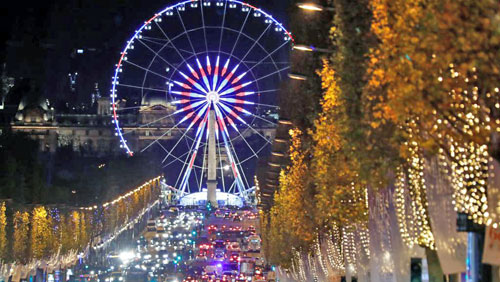 o The Big Wheel was the scene of a large protest by Paris fairground stall holders in November to demand that the Ferris wheel in the Place de la Concorde remain standing. The 230 foot-high wheel has been the star of the Christmas village on the Champs-Élysées since 2000, and protesters want the wheel to remain there until May of 2017 as was promised by the City of Paris. o French Interior Minister Bernard Cazeneuve was appointed as the new Prime Minister on December 6 after Manual Valls resigned to seek the Socialist nomination in next year's presidential election. Cazeneuve, who has overseen the security forces' reaction to a string of jihadist attacks in France over the past two years, will take control of the Socialist government until the election in May. [Expatica] o Impressionists on the train ~ express trains, decorated with the art of Monet both inside and out, will transport you from Paris to the artist's estate in Giverny and on to Rouen. The work of other Impressionists, along with architectural details from the ceiling of the Musée d'Orsay, will envelop you on your journey on Saturdays and Sundays. Three trains depart from Gare St-Lazare at 11:05 AM, continuing to Vernon-Giverny and then to Rouen. Trains return at 6:12 PM, and ticket prices start at $14 per person. They are available on www.raileurope.com. [adapted from article by Mary Forgione in the Los Angeles Times] o Some changes in Paris were evident on our recent visit, including individuals zipping along on roller blades. Even though rollerblading in groups in Paris on Friday nights is a regular occurrence, seeing solitary men and women doing so quite often was a bit of a surprise. An apparent fashion trend was men in shorts on the streets of Paris ~ both locals and tourists. We never saw that in all our years visiting the City of Light, and it must be a sign that casual attire is more acceptable these days. Finally, another transportation phenomenon was that entire families ~ moms, dads and the kids ~ travel around the city on little scooters (no, not Vespas ~ scooters). 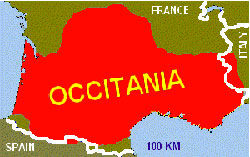 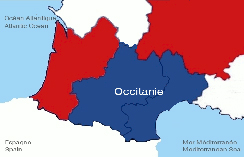 o
As we reported in a recent newsletter, last January 1st
marked the beginning of new regional designations. Since then, at
the end of September, another change was made: the former
Midi-Pyrénées and Languedoc regions are now Occitanie ~ a
reference to the even larger region once known as Occitania as shown on
the map on the right. The region takes in the départements
of Ariège, Aude, Aveyron, Gard, Gers, Haute-Garonne,
Haute-Pyrénées, Hérault, Lot, Lozère,
Pyrénées Orientales, Tarn and Tarn-et-Garonne. The
Occitan language was the first literary language of modern Europe, and
is a Romance language. It was spoken by King Richard I (Richard
the Lionheart) and his mother, Eleanor of Aquitaine. Troubadours
spoke it as well, and wrote songs with Occitan lyrics. It is not
a dialect or patois of French,
but a language unto itself and still survives to this day. o
As we reported in a recent newsletter, last January 1st
marked the beginning of new regional designations. Since then, at
the end of September, another change was made: the former
Midi-Pyrénées and Languedoc regions are now Occitanie ~ a
reference to the even larger region once known as Occitania as shown on
the map on the right. The region takes in the départements
of Ariège, Aude, Aveyron, Gard, Gers, Haute-Garonne,
Haute-Pyrénées, Hérault, Lot, Lozère,
Pyrénées Orientales, Tarn and Tarn-et-Garonne. The
Occitan language was the first literary language of modern Europe, and
is a Romance language. It was spoken by King Richard I (Richard
the Lionheart) and his mother, Eleanor of Aquitaine. Troubadours
spoke it as well, and wrote songs with Occitan lyrics. It is not
a dialect or patois of French,
but a language unto itself and still survives to this day. The new region The historic region o Monaco hosts the International Circus Festival presenting both traditional and 21st century circuses from countries far and wide. January 19 - 29. More information at www.montecarlofestival.mc. o The 2017 Fête du Citron will take place in Menton February 11 through March 1. Citrus statues some 30 feet high incorporating 140 tons of fruit will fill the town! Details at www.fete-du-citron.com.  o Hodler, Monet and Munch will be the stars of an art exhibit featuring three important movements in European art: Impressionism, Post-Impressionism and Symbolism at the Marmottan-Monet Museum until January 22. Information at www.marmottan.fr. o René Magritte is featured at the Centre Pompidou until January 23 ~ an exhibit offering a new perspective on his five constant references: fire, shadows, curtains, words and the fragmented body. This show focuses on the artist's thinking about realism, appearance and the deceptive world, urging the viewer to question what he or she sees. Details at www.centrepompidou.fr. o The Musée du Louvre has opened its new Pavillon du l'Horloge (Clock Pavilion) intended to make it easier for visitors to understand the history of the museum and make it simpler to navigate the various wings and exhibits. It offers interactive models and digital displays with archived documents and artwork from the Louvre collection. Read more at www.louvre.fr. o DID YOU KNOW? The Spanish Steps in Rome are neither Spanish nor Italian. They were donated by France to the city in 1725 to cover the muddy slope from Piazza di Spagna (the Spanish Square) to the French convent and church, Trinità dei Monti. The elaborate steps were recently re-opened in late September after an 11-month cleaning, weeding, and the installation of new drainage and video surveillance systems at a cost of $1.7 million.
In the US . . . 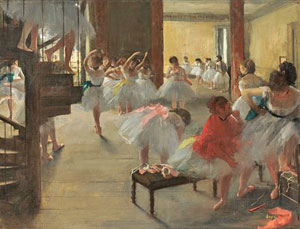 o The Portland Museum of Art in Maine
will present The
Art Books of Henri Matisse. His twelve plus
fully-illustrated books showed his printmaking skills and his effort to
harmonize the form and content. There are framed illustrations
from four of his books on exhibit. Until December 31, 2016.
For more information www.portlandmuseum.org. o The Portland Museum of Art in Maine
will present The
Art Books of Henri Matisse. His twelve plus
fully-illustrated books showed his printmaking skills and his effort to
harmonize the form and content. There are framed illustrations
from four of his books on exhibit. Until December 31, 2016.
For more information www.portlandmuseum.org.o On January 6, 2017 at 8PM Carnegie Hall in New York City will present Anne Barrere in the title role in a performance of Piaf! The Show which has already been enjoyed by a half million people in thirty countries. The musical was inspired by the award-winning movie La Vie en Rose and tells the life story of the "Little Sparrow" through her greatest hits. The performance also marks the 60th anniversary of Edit Piaf's own Carnegie Hall appearance. https://www.carnegiehall.org/Calendar/. o Degas: A New Vision is the exhibit in Houston at the Museum of Fine Arts. Some 200 works from both private and public collections are brought together for one of the most extensive exhibits of his work in decades. The show includes paintings, pastels, photography and sculpture. Through January 8. Details at www.mfah.org. o Fort Worth, Texas' Kimbell Art Museum will host an exhibit of Monet: The Early Years. Monet's youth was spent in Normandy where he met his mentor, Eugène Boudin, and this exhibit follows Monet's evolution from the 1850s to 1872 when he settled in Argenteuil. The sixty works include some of his most loved paintings to those seldom seen by the public. Until January 29. Information at www.kimbellart.org. o The Barnes Foundation in Philadelphia is currently hosting more than 170 images of Cartier-Bresson, Brassaï, Atget and other photographers in its show entitled Live and Life Will Give You Pictures: Masterworks of French Photography, 1890-1950. This was a period of great changes in France, and the exhibit is a glimpse into daily life of these six decades. Most of the works have not been seen by the public before. Information at www.barnesfoundation.org. o The Seattle Art Museum will present Yves Saint Laurent: The Perfection of Style, chronicling the fashion designer's 44-year career from the time he began with the House of Dior at the age of 19. Displayed will be garments never before seen by the public, haute-couture and ready-to-wear designs, as well as sketches and swatches from his own shows. Through January 8. More information at www.seattleartmuseum.org. o A wide variety of themes depict the art of Jean-Honoré Fragonard in the exhibit entitled Fragonard: Drawing Triumphant ~ Works from New York Collections. There are over 100 of his works on paper from sketches to finished pieces. Through January 8 at the Metropolitan Museum of Art, New York. Details at metmuseum.org. o Pierre Chareau, a much sought-after architect and designer in 1920s and 1930s Paris, is the subject of the US's first exhibit of his work entitled Pierre Chareau: Modern Architecture and Design. It brings together about 180 pieces of furniture, lighting fixtures and other items from collections around the world. In Paris he is best known for Maison de Verre, a landmark of Modern architecture on the Left Bank. Through March 26 at the Jewish Museum, 5th Avenue and 92nd Street, New York City. Further information at thejewishmuseum.org. THE BOOKSHELF: MARIE ANTOINETTE'S DARKEST DAYS ~ Prisoner No. 280 in the Conciergerie a book by Will Bashor
This
is a totally absorbing and objective account of the
imprisonment of Marie Antoinette after her arrest on August 2nd 1793,
recounting the misery she endured in both being separated from her
children and the personal humiliation she faced day to day. Her
husband,
King Louis XVI had already been guillotined, and unlike most prisoners
who came to this prison only a few days before meeting the same fate,
the Queen, an Austrian by birth and intensely disliked in France, was
kept as a hostage of sorts. During her imprisonment, the
Revolutionary government
negotiated in vain with the Austrian government, whose army was at the
French border, to release her to them in exchange for their
withdrawal. There wasn't going to be any deal. As much as
the nations of Europe were enraged by the King's execution, Marie
Antoinette would remain in prison.
The author's research found several different accounts of her time in the Conciergerie, and he deftly presented her story without favoritism for either side. Readers will learn so much more about the Queen of France than they have ever known before ~ not about her extravagances and life at Versailles, but of the last 76 days of her life when she suffered not knowing how her children were, endured a total lack of privacy, and became ill due to the circumstances in which she was forced to live. Her young son, heir to the throne, would fare very badly, spending fifteen months in solitary confinement in the Temple, receiving food through a hole in his cell door ~ a cell that no one else entered, that was never cleaned, from which nothing was ever removed, and which had no fresh air. There were those, of course, throughout this Reign of Terror who were sympathetic toward the royals and did what they could (without being caught) to make their lives easier, some even plotting to help the Queen escape. No plans succeeded and even if they weren't found out at the time, eventually they all paid for their actions. The book is filled with intrigue as sympathetic jailers and others plotted in secret, Although we know she did not survive, there was still the fantasy that something might work in her favor. What you do learn from Marie Antoinette's Darkest Days is that all the author's sources saw characteristics in her not widely known: she never wanted anyone to get into trouble on her part and asked no one for help; she cared about her children above herself; she was kind to those who tended her daily needs and never was she condescending or cruel towards them. Of course, we also read that before the Revolution she was flagrantly extravagant while the poor suffered. There was certainly cause for people to dislike her with intensity. But, once she was a widow and imprisoned, those around her saw a different person. 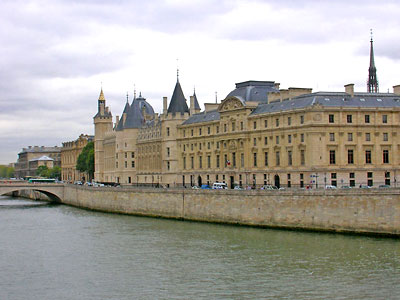 There is so much more to the story ~ her being paraded through the streets of Paris in an open cart and being jeered by the assembled crowds, the fate of her young son and her sister-in-law, the survival of her daughter and her subsequent life, the return of the monarchy to France for a brief time ~ but perhaps we have already told too much. It is a well-written, fascinating look into the part of French history, the Reign of Terror, that the French would surely like to forget. We highly recommend this book whether you are a history buff, a francophile, or just someone who wants to know what really went on behind the scenes. Will Bashor's incredible accounting of Marie Antoinette's last days is praiseworthy and gives us all a completely different perspective on this period in French history and the plight of its Queen. [Published August 1, 2016 / eBook on December 1, 2016 by Rowman & Littlefield ISBN 9781442254992 / electronic ISBN 9781442255005] The Conciergerie today
|
 previous
page
next page
previous
page
next page  |